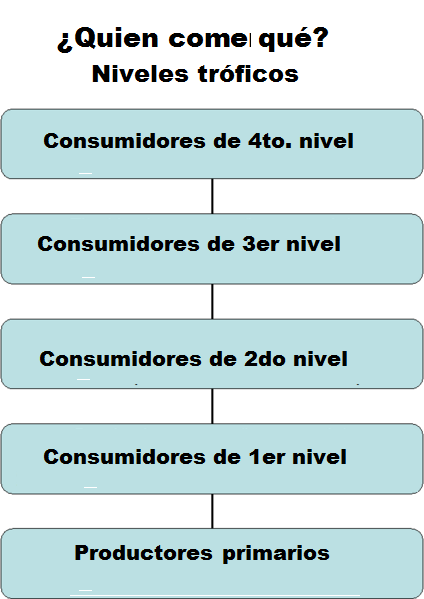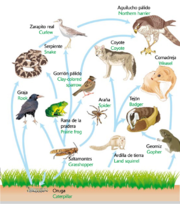Diferencia entre revisiones de «¿Quién come qué?»
(cat) |
(→Problemas potenciales: k) |
||
| Línea 48: | Línea 48: | ||
<gallery> | <gallery> | ||
Archivo:Blatta orientalis Vic Catalonia 106.JPG|Blatta orientalis <br>[[Omnívoro|omnivora]] | Archivo:Blatta orientalis Vic Catalonia 106.JPG|Blatta orientalis <br>[[Omnívoro|omnivora]] | ||
| − | Archivo:Tortoise Galapagos 3144.jpg| | + | Archivo:Tortoise Galapagos 3144.jpg|Galápagos<br>[[Herbívoro|herbívora]] |
File:Goat eating leeves.jpg|consumidor de 1<sup>er</sup> nivel | File:Goat eating leeves.jpg|consumidor de 1<sup>er</sup> nivel | ||
File:Ailurus fulgens RoterPanda LesserPanda.jpg|Panda rojo<br>[[Carnívoro|carnívoro]] | File:Ailurus fulgens RoterPanda LesserPanda.jpg|Panda rojo<br>[[Carnívoro|carnívoro]] | ||
Revisión de 07:42 24 ene 2013
Contenido
Quién come que?
Calificación de los alumnos
Tested
Biología 1er ciclo
Niveles tróficos de la cadena alimentaria
Materiales
Materiales necesarios para el profesor:
- Esquema de los niveles tróficos e ilustraciones
- Ejemplo de cadena trófica
Materiales que cada alumno requerirá
- Revistas con animales (vg. National Geographic, Scientific American)
- Tijeras
- Pegamento en barra
- papel Kraft
Guiones
V.infra.
Descripción de la actividad
En primer lugar el profesor explica los cinco niveles tróficos de una cadena alimenticia a sus alumnos usando un papelografo con un cadena alimenticia típica (lámina adj.) Luego que han logrado un conocimienton de niveles tróficos, autotrofos y heterotrofos, cada estudiante mirará en sus revistas y recortará las imagenes de animales para elaborar su propia cadena alimenticia. Luego de terminado su trabajo la comparte con el grupo.
Planificación de la clase
- Un volante de la figura de Icarito (lámina 1) para cada alumno.
- Introduzca las diferencias entre autotrofo y hetertrofo.
- Verifique que conocen las diefrencias entre carnivoros, omnivoros, and herbivoros.
- Subiendo porlos niveles asegurese que los estudiantes comprenden las características específicas.
- entregue revistas y tijeras a cada estudiante para recortar animales y cadenas alimenticias.
- una vez que tienen material entregue pegamento en barra y papel Kraft y cada alumno para que peguen sus "recortables".
- seguido entregue etiquetas de cada nivel de la cadena alimentaria.
- Pida a los estudentes que compartan su experiencia en grupos de pocas personas (4-5).
Problemas potenciales
Algunos problemas que peudes encotrar es léxica y la confusión de distinguir entre los diferentes niveles tróficos.
Blatta orientalis
omnivoraGalápagos
herbívora- Goat eating leeves.jpg
consumidor de 1er nivel
Panda rojo
carnívoroGusano de tierra
detrívoro
Transversales con Artes plásticas
Los alumnos harán dibujos de algunos animales mejorando sus experiencias en artes visuales.
enlace a Literatura
Babies in the Bayou de Jim Arnosky
Connecciones con estandares educacionales
Visual Arts – 5.29 Students use the elements and principles of two and three dimensional design in the visual arts, including line, color, shape, and texture, in creating, viewing, and critiquing.
Organisms, Evolution, and Interdependence – 7.13 Students understand the characteristics of organisms, see patterns of similarity and differences among living organisms, understand the role of evolution, and recognize the interdependence of all systems that support life.
Avanzando
Once you have covered a simple food chain or web you may continue the lesson by talking about different relationship between animals other than predator and prey situations. For instance relationships that benefit both organisms could be explored.
Citas y links
http://www.instructorweb.com/lesson/animals.asp This website would be very helpful when looking for handouts or a follow up activity.
Reflexiones
This lesson was very interesting for us to do because it produced many questions by the students that also challenged us. One of the questions that was asked numerous times was whether or not elephants eat other animals like a monkey or something along those lines. The challenge was not in the answer here but rather once we told them that they did not and that they only eat leaves and smaller things, they wanted to know how elephants got so big if all they ate were plants. This was a challenge for us to explain to them. It was also interesting to see how some students took the initiative to make their food webs very complex while others barely finished the bear minimum. We were a little pressed for time though I feel like a half an hour would have been sufficient but only twenty minutes was a little more difficult.
We have recently received feedback from the classroom teacher that we work with on the lesson and she has told us that having the list of vocabulary was crucial to the project itself. She said that many times, students just need the confidence of having the words next to the to look at whenever they need to rather than constantly having to ask how to spell something. Many students may not be confident in themselves or are too shy to ask in the fir





